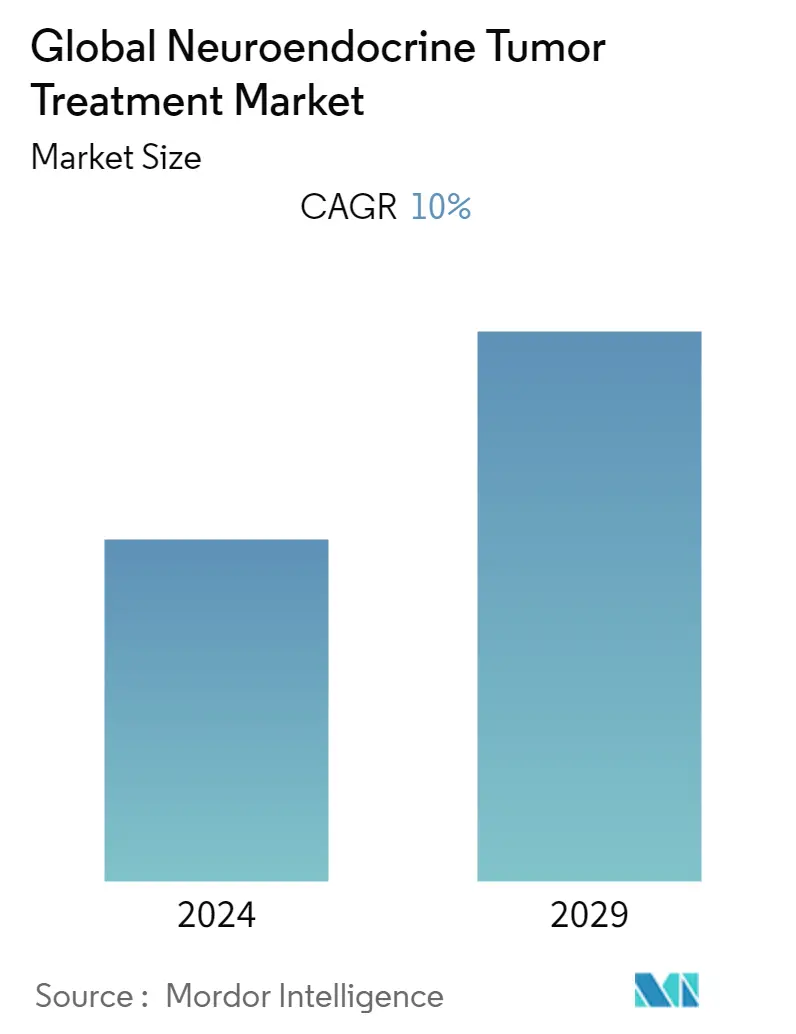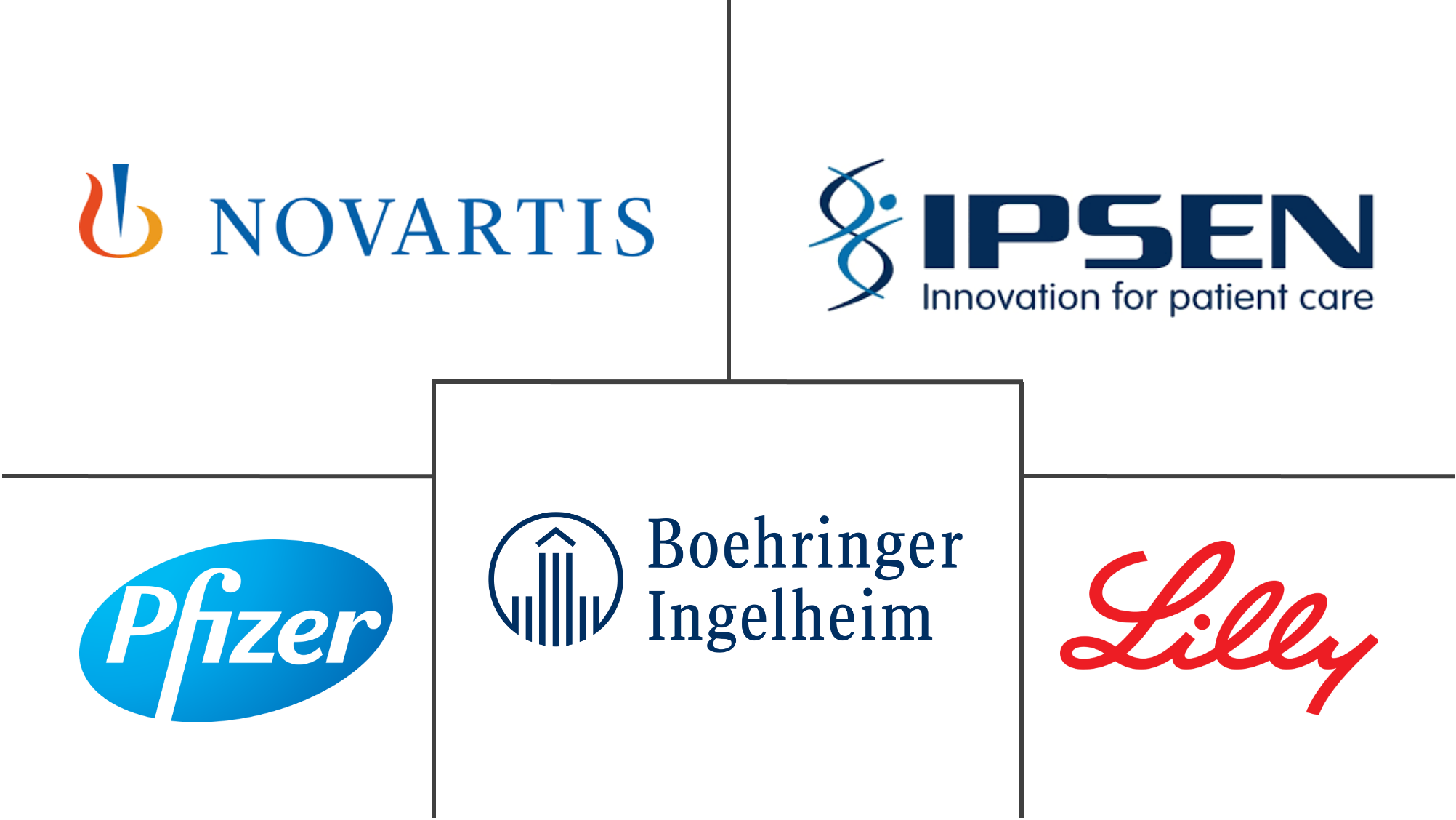Market Size of Global Neuroendocrine Tumor Treatment Industry

| Study Period | 2019 - 2029 |
| Base Year For Estimation | 2023 |
| Forecast Data Period | 2024 - 2029 |
| CAGR | 10.00 % |
| Fastest Growing Market | Asia Pacific |
| Largest Market | North America |
Major Players
*Disclaimer: Major Players sorted in no particular order |
Neuroendocrine Tumor Treatment Market Analysis
The Neuroendocrine Tumor Treatment Market is projected to register a CAGR of 10% during the forecast period (2022 - 2027).
The ongoing outbreak of COVID-19 showed an impact on the Neuroendocrine Tumor Treatment market because hospital and healthcare services were significantly reduced due to social distancing measures taken by governments across the globe. Moreover, the COVID-19 pandemic not only affected the global economy but also showed a huge impact on the functioning of general hospital care for non-COVID-19 patients in hospitals across the globe. An article titled 'Impact of the COVID-19 pandemic on neuroendocrine tumour services in England' published in the journal of Endocrine in January 2021 indicated that during the COVID-19 pandemic, there were particular concerns regarding the specialist tumor treatment services. The article stated that the major disruption in specialist neuroendocrine treatment services included relevantly increased waiting times for both new and follow-up appointments, with an especially substantial delay of follow-up appointments. The lag in other treatment services during the COVID-19 pandemic greatly impacted the neuroendocrine tumor treatment market.
The neuroendocrine tumor treatment market is driven by the factors such as the growing prevalence of neuroendocrine cancer, technological advancements in the field of neuroendocrine tumor treatment, and the rise in the number of government initiatives. An article titled 'Advances in the Diagnosis and Therapeutic Management of Gastroenteropancreatic Neuroendocrine Neoplasms (GEP-NENs)' published in the Journal of Cancers in April 2022 indicated the occurrence of neuroendocrine have been largely increasing in the past three to four decades. Also, there has been an increase in the innovations in the treatment methods for neuroendocrine treatment including somatostatin analogs, INF α, Radionuclide Treatment, Transarterial treatment, Targeted therapy, immunotherapy, CAR-T-Cell therapy, bispecific antibodies, vaccines, Cytotoxic Chemotherapy of Highly Differentiated and Low Differentiated G1 and G2 GEP NETs. The rising number of innovative treatments for the neuroendocrine tumor in the recent years have significantly improved the growth of the neuroendocrine tumor treatment in recent years.
The Department of Health of Commonwealth of Australia in January 2022 released a grant of USD 63.4 million for the rare cancers and rare diseases research under the 2021 Rare Cancers, Rare Diseases and Unmet Need (RCRDUN) grant opportunity. Specifically, the Flinders University received a funding of USD 2,374,220.10 for the project 'Implementing a Nurse-Enabled, Shared-Care Model to Address Unmet Needs of People with Neuroendocrine Tumours: the AUS-NET Trial'. The investments in the rare cancer treatment studies are a part of the long-term national health plan of the Australian government. Such investments by various government organizations are likely to add to the growth of the neuroendocrine tumor treatment market in the forecast period.
However, the high cost of neuroendocrine tumor treatment methods along with the lack of awareness among people are hindering the growth of the studied market.
Neuroendocrine Tumor Treatment Industry Segmentation
As per the scope of the report, the neuroendocrine tumor is the rare tumor that arises from specialized body cells, called neuroendocrine cells, is known as neuroendocrine tumor. The neuroendocrine tumor arises from cells that produce hormones thus, it produces and releases hormones into the blood in response to signals received from the nervous system. It can occur anywhere in the body, but most commonly occurs in the pancreas, digestive tract, lungs, rectum, and appendix. Neuroendocrine tumor can be either benign (non-cancerous) or malignant (cancerous). The Neuroendocrine Tumor Treatment Market is segmented by Products (Somatostatin Analogs (SSAs), Targeted Therapy, Chemotherapy and Others), Indication (Lungs, Pancreas, Gastrointestinal and Others), End User (Hospitals, Clinics and Others) and Geography (North America, Europe, Asia-Pacific, Middle East and Africa and South America). The Market report also covers the estimated market sizes and trends of 17 countries across major regions globally. The report offers values in (in USD million) for the above segments.
| By Products | |
| Somatostatin Analogs (SSAs) | |
| Targeted Therapy | |
| Chemotherapy | |
| Others |
| By Indication | |
| Lungs | |
| Pancreas | |
| Gastrointestinal | |
| Others |
| By End User | |
| Hospitals | |
| Clinics | |
| Others |
| Geography | ||||||||
| ||||||||
| ||||||||
| ||||||||
| ||||||||
|
Global Neuroendocrine Tumor Treatment Market Size Summary
The neuroendocrine tumor treatment market is experiencing significant growth, driven by the increasing prevalence of neuroendocrine cancers and advancements in treatment technologies. The market is characterized by the development and adoption of innovative therapies such as somatostatin analogs, targeted therapy, and immunotherapy, which have enhanced treatment outcomes. Government initiatives and funding, particularly in regions like Australia, are further propelling market expansion by supporting research and development in rare cancer treatments. Despite the challenges posed by the COVID-19 pandemic, which disrupted healthcare services and delayed treatments, the market is poised for robust growth due to the rising demand for effective treatment options and the introduction of new therapeutic modalities.
In North America, the market is bolstered by a high awareness of advanced treatment options and a growing number of neuroendocrine cancer cases. The approval of new drugs by regulatory bodies like the FDA and supportive insurance policies are contributing to market growth in this region. Key players in the market are focusing on strategic initiatives such as product launches, partnerships, and technological innovations to strengthen their market position. Companies like Pfizer Inc., Novartis AG, and Ipsen are leading the charge in developing and distributing neuroendocrine tumor treatments, ensuring a competitive landscape that fosters continued advancements and accessibility in patient care.
Global Neuroendocrine Tumor Treatment Market Size - Table of Contents
-
1. MARKET DYNAMICS
-
1.1 Market Overview
-
1.2 Market Drivers
-
1.2.1 Increasing Prevalence of Neuroendocrine Carcinoma
-
1.2.2 Technological Advancements
-
1.2.3 Rising Number of Government Initiatives
-
-
1.3 Market Restraints
-
1.3.1 High Cost of Development
-
1.3.2 Lack of Awareness Among People
-
-
1.4 Porter's Five Force Analysis
-
1.4.1 Threat of New Entrants
-
1.4.2 Bargaining Power of Buyers/Consumers
-
1.4.3 Bargaining Power of Suppliers
-
1.4.4 Threat of Substitute Products
-
1.4.5 Intensity of Competitive Rivalry
-
-
-
2. MARKET SEGMENTATION
-
2.1 By Products
-
2.1.1 Somatostatin Analogs (SSAs)
-
2.1.2 Targeted Therapy
-
2.1.3 Chemotherapy
-
2.1.4 Others
-
-
2.2 By Indication
-
2.2.1 Lungs
-
2.2.2 Pancreas
-
2.2.3 Gastrointestinal
-
2.2.4 Others
-
-
2.3 By End User
-
2.3.1 Hospitals
-
2.3.2 Clinics
-
2.3.3 Others
-
-
2.4 Geography
-
2.4.1 North America
-
2.4.1.1 United States
-
2.4.1.2 Canada
-
2.4.1.3 Mexico
-
-
2.4.2 Europe
-
2.4.2.1 Germany
-
2.4.2.2 United Kingdom
-
2.4.2.3 France
-
2.4.2.4 Italy
-
2.4.2.5 Spain
-
2.4.2.6 Rest of Europe
-
-
2.4.3 Asia Pacific
-
2.4.3.1 China
-
2.4.3.2 Japan
-
2.4.3.3 India
-
2.4.3.4 Australia
-
2.4.3.5 South Korea
-
2.4.3.6 Rest of Asia-Pacific
-
-
2.4.4 Middle East and Africa
-
2.4.4.1 GCC
-
2.4.4.2 South Africa
-
2.4.4.3 Rest of Middle East and Africa
-
-
2.4.5 South America
-
2.4.5.1 Brazil
-
2.4.5.2 Argentina
-
2.4.5.3 Rest of South America
-
-
-
Global Neuroendocrine Tumor Treatment Market Size FAQs
What is the current Global Neuroendocrine Tumor Treatment Market size?
The Global Neuroendocrine Tumor Treatment Market is projected to register a CAGR of 10% during the forecast period (2024-2029)
Who are the key players in Global Neuroendocrine Tumor Treatment Market?
Pfizer Inc., Novartis AG, Ipsen, Boehringer Ingelheim International GmbH and Eli Lilly & Company are the major companies operating in the Global Neuroendocrine Tumor Treatment Market.

